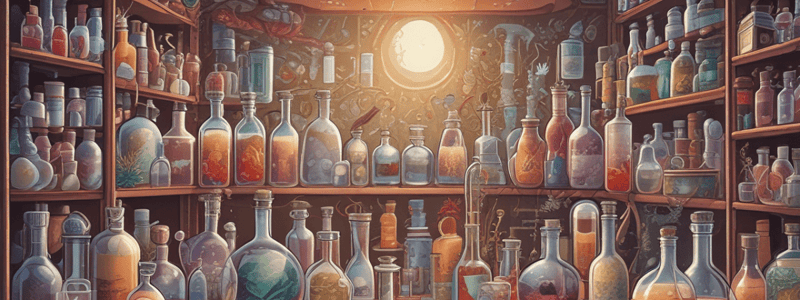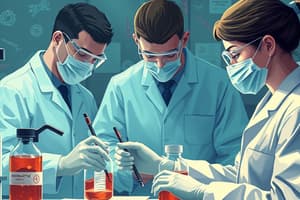Podcast
Questions and Answers
What is the primary reason for obtaining specimens properly during collection?
What is the primary reason for obtaining specimens properly during collection?
- To minimize the possibility of introducing contaminating microorganisms (correct)
- To use the correct type of container for the specimen
- To ensure the specimen is handled by a trained laboratory technician
- To ensure the specimen is transported quickly to the laboratory
What type of container is recommended for collecting large quantities of urine?
What type of container is recommended for collecting large quantities of urine?
- Universal container
- 250ml wide mouthed screw-capped bottle (correct)
- Syringe and needle
- Blood culture bottle
What is the purpose of a blood culture bottle?
What is the purpose of a blood culture bottle?
- To collect urine samples
- To collect blood for serological examination
- To hold 50ml of liquid medium and 5-10ml of patient's blood (correct)
- To collect blood for parasitological examination
When is the best time to collect specimens?
When is the best time to collect specimens?
What is the main component of a swab?
What is the main component of a swab?
What type of specimen is a wide mouthed disposable container used for?
What type of specimen is a wide mouthed disposable container used for?
Why are syringes and needles used in specimen collection?
Why are syringes and needles used in specimen collection?
What is the purpose of using a universal container for feces?
What is the purpose of using a universal container for feces?
What is the primary function of the P wave in an ECG?
What is the primary function of the P wave in an ECG?
What is the purpose of using gel with ions during an ECG?
What is the purpose of using gel with ions during an ECG?
Which of the following is NOT a detail that an ECG can provide?
Which of the following is NOT a detail that an ECG can provide?
What is the significance of checking a patient's sodium levels during an ECG?
What is the significance of checking a patient's sodium levels during an ECG?
What is the term for an unusually fast heart rate?
What is the term for an unusually fast heart rate?
What is the QRS complex wave indicative of?
What is the QRS complex wave indicative of?
What is the primary function of an electrocardiograph?
What is the primary function of an electrocardiograph?
What is the origin of electricity in the heart?
What is the origin of electricity in the heart?
Which of the following is a symptom that may indicate the need for an electrocardiogram?
Which of the following is a symptom that may indicate the need for an electrocardiogram?
What is the direction of electricity in Lead I of Einthoven's triangle?
What is the direction of electricity in Lead I of Einthoven's triangle?
Which electrode is NOT used in measuring ECG in hospitals?
Which electrode is NOT used in measuring ECG in hospitals?
What is the mechanically most important chamber of the heart?
What is the mechanically most important chamber of the heart?
Why is measuring the electricity of Lead II important?
Why is measuring the electricity of Lead II important?
Who developed the ECG?
Who developed the ECG?
Flashcards are hidden until you start studying
Study Notes
Specimen Collection and Transportation
- Proper specimen collection and transportation are crucial because the quality of the specimen directly affects the laboratory results.
- Specimens should be obtained properly to minimize the possibility of contaminating microorganisms that are not involved in the infectious process.
Containers for Specimen Collection
- Feces: Universal container with a spoon attached to the inside of the screw cap.
- Urine: Universal container for small quantities, and 250ml wide-mouthed screw-capped bottles for larger quantities.
- Sputum: Wide-mouthed disposable containers (not universal containers).
- Blood: Without anticoagulant for serological examination, and with EDTA for parasitological examination.
- Blood culture bottle: Must be at least large enough to hold 50ml of liquid medium and 5-10ml of patient's blood.
Syringe and Needle for Aspiration
- Used for collecting specimens from: • Wound pus • CSF • Pleural effusion • Amniotic fluid • Synovial fluid
Swabs for Specimen Collection
- Suitable for collecting exudates from: • Throat • Nose • Ear • Skin • Wounds • Accessible lesions
- Consist of sterile pledge of absorbent material (usually cotton-wool or synthetic fiber) mounted on a thin wire stick.
Special Purpose Swabs
- Baby swabs
- Pre-nasal swabs
- Post-nasal swabs
- Laryngeal swabs
- High vaginal and cervical swabs
Specimen Collection Guidelines
- Time of collection: • During the acute phase • Before antimicrobial therapy
What is Electrocardiograph?
- An Electrocardiogram (ECG) records the electrical signals in the heart.
- It's a common and painless test used to quickly detect heart problems and monitor the heart's health.
Why is ECG done?
- To diagnose many common heart problems, including irregular heart rhythms (arrhythmias), blocked or narrowed arteries in the heart, and previous heart attacks.
- To monitor heart disease treatments, such as pacemakers.
Indications for ECG
- Chest pain
- Dizziness, lightheadedness or confusion
- Heart palpitations
- Rapid pulse
- Shortness of breath
- Weakness, fatigue or a decline in ability to exercise
Heart's Electrical Activity
- The sinoatrial node, located in the right atrium, is the origin of electricity of the heart.
- The electrical activity is sent to the atrioventricular node and then to the purkinjee fibers of the heart.
- Electrically, the most important chamber of the heart is the right atrium.
- Mechanically, the most important chamber of the heart is the left ventricle.
ECG Leads
- Einthoven's triangle has three leads:
- Lead I: direction of electricity from the right arm to the left arm.
- Lead II: direction of electricity from the right arm to the left leg.
- Lead III: direction of electricity from the left arm to the left leg.
- Lead II is important because it directs the electrical pulse from the right atrium to the left ventricle.
Measuring ECG
- Hospitals use 12 electrodes to measure ECG:
- Right arm, left arm, right leg, left leg, and 8 electrodes between the 4th and 5th ribs on the left and right side of the sternum.
- A single electrode is positioned between the 4th intercostal space.
ECG Waves
- P wave: indicates depolarization of the atrium.
- QRS complex: series of waves that indicate depolarization of the ventricle.
- T wave: represents repolarization of the ventricle.
Important to Know
- The repolarization of the atrium is small and will disappear in QRS complex.
- Gel containing ions can be used to increase conductivity during ECG.
- Sodium is an important electrolyte for the heart movement, and checking the patient's electrolyte levels is important.
What do the Results Tell Us?
- Heart rate: ECG can help identify an unusually fast heart rate (tachycardia) or an unusually slow heart rate (bradycardia).
- Heart rhythm: ECG can detect irregular heartbeats (arrhythmias).
- Heart attack: ECG can show evidence of a previous heart attack or one that's currently happening.
- Blood and oxygen supply to the heart: ECG can provide information about this.
- Heart structure changes: ECG can provide clues about an enlarged heart, heart defects, and other heart problems.
Studying That Suits You
Use AI to generate personalized quizzes and flashcards to suit your learning preferences.





